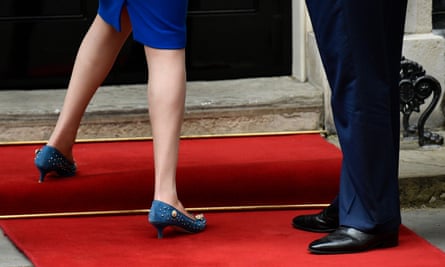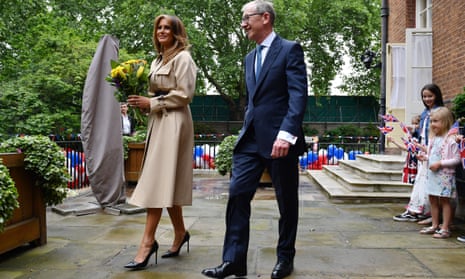It’s hard to imagine men enduring decades of pain and long-term physical injury just to “look the part” in the workplace – after all, many bemoan the necktie as too restrictive for the daily grind.
Now consider this: millions of women around the world, at all levels of the workplace hierarchy, have consistently spent their working hours tortured by blisters, bloodied flesh, foot pain, knee pain, back pain and worse, as a result of the pressure to conform to an aesthetic code – sometimes explicitly written into contracts or policy, more often subliminally expected as a societal and cultural standard – that deems it appropriate to wear high heels.
Last week, led by Yumi Ishikawa, who was forced to wear high heels when she worked in a funeral parlour, a group of Japanese women have signed a petition demanding employers be banned from making women wear heels as part of an enforced dress code. A groundswell of support for the campaign, dubbed #KuToo (a play on kutsu, meaning shoes, and kutsuu, meaning pain, in Japanese and inspired by the #MeToo movement), has gained global attention for their cause and reopened the debate about the politics of footwear. Takumi Nemoto, Japan’s health and labour minister, defended the dress codes, telling a legislative committee that he believed it “is socially accepted as something that falls within the realm of being occupationally necessary and appropriate”.
As a former board director at Marks & Spencer and now non-executive director of the Peninsula Hotel Group and Natural History Museum, Kim Winser is well versed in the politics of dressing for success. “I currently sit on boards in Japan, Hong Kong and London, and there’s no question that professional dress codes are different around the world,” she says. “In Asia, for example, there is an expectation that women wear skirts or dresses, rather than trouser suits.
“I believe it is appropriate to set a sartorial standard of professional formality to suit the role, so it’s OK to expect a man or woman to wear a jacket or suit to client-facing meetings, for example, and to ensure employees aren’t scruffy. But to demand women wear a certain height of shoe is not acceptable.”
Winser, who founded the workwear fashion label Winser London, added: “I wear heels when I feel they work with an outfit, and I know lots of women who enjoy wearing them, but I would not expect to be told to wear them.” Fascination with the footwear appears to be endless, with a new exhibition celebrating Manolo Blahnik’s work opening at London’s Wallace Collection tomorrow.
In my former roles as a newspaper fashion editor and TV fashion correspondent, I revelled in the regular opportunities I had to dress up in exotic footwear. However, motherhood and life as a freelance journalist based in a rural village have made it necessary to adapt to changing needs, so trainers, brogues and wellies now feature more frequently. While I find heels empowering and enjoyable to wear on the right occasion, I would challenge any employer who stipulated I was contractually obliged to do so.
Emma Supple, vice-president of the College of Podiatry, raised the issue at government level in the UK in 2009 when she presented a paper on foot health, sharing concerns that a number of her clients faced losing their jobs because they couldn’t wear the heeled shoes that were part of their uniform. “It is a form of subjugation when a woman is being made to wear a three-inch stiletto and not allowed to choose a more comfortable alternative,” she said. “These shoes can hurt or cause long-term damage, from crippling blisters, corns and calluses to knee, back and more musculoskeletal damage. It’s just not fair to expect a woman to do a day’s work in a vice: it will impact on her performance and creates a serious gender imbalance.”
When Nicola Thorp, an agency receptionist, was sent home for wearing flat shoes on her first day at PwC in December 2015, it caused an outcry and triggered a government investigation into sexist work dress codes. Helen Jones, who was chair of the Commons petitions committee, said: “What we found shocked us. We found attitudes that belonged more … I was going to say in the 1950s but probably the 1850s might be more accurate, than in the 21st century. Threatened with dismissal if they complained, they were forced to bear pain all day, or to wear clothing that was totally unsuitable for the tasks that they were asked to perform, or to dress in a way that they felt sexualised their appearance and was demeaning.” British Columbia in Canada passed a law in 2017 banning mandatory heels in the workplace, but few places have followed suit. At the 2015 Cannes film festival, several women were turned away from the premiere of Carol – ironically, a film about liberation from patriarchal control – because they were wearing flat shoes.

Jodie Comer, who won a Bafta for best TV actress this year, has expressed relief that Villanelle, her serial killer character in Killing Eve, was not expected to conduct her crimes in killer heels.
In a world where most of us have become accustomed to the cushioned soles of trainers for everyday wear, women are digging in their heels – even when society still decrees they do otherwise.
Well-heeled
From Melania Trump, who wore teetering Manolo Blahniks to a royal garden party last week, and Meghan Markle, who wore four-inch Aquazzura heels throughout her pregnancy, to Amal Clooney and Karren Brady, there’s no shortage of high-heel wearers in public life
Marilyn Monroe asked Italian shoemaker Salvatore Ferragamo to cut a quarter of an inch off one of her heels to accentuate her wiggle
The fuss over Theresa May’s kitten heels highlighted the potency of a power shoe

Comments (…)
Sign in or create your Guardian account to join the discussion